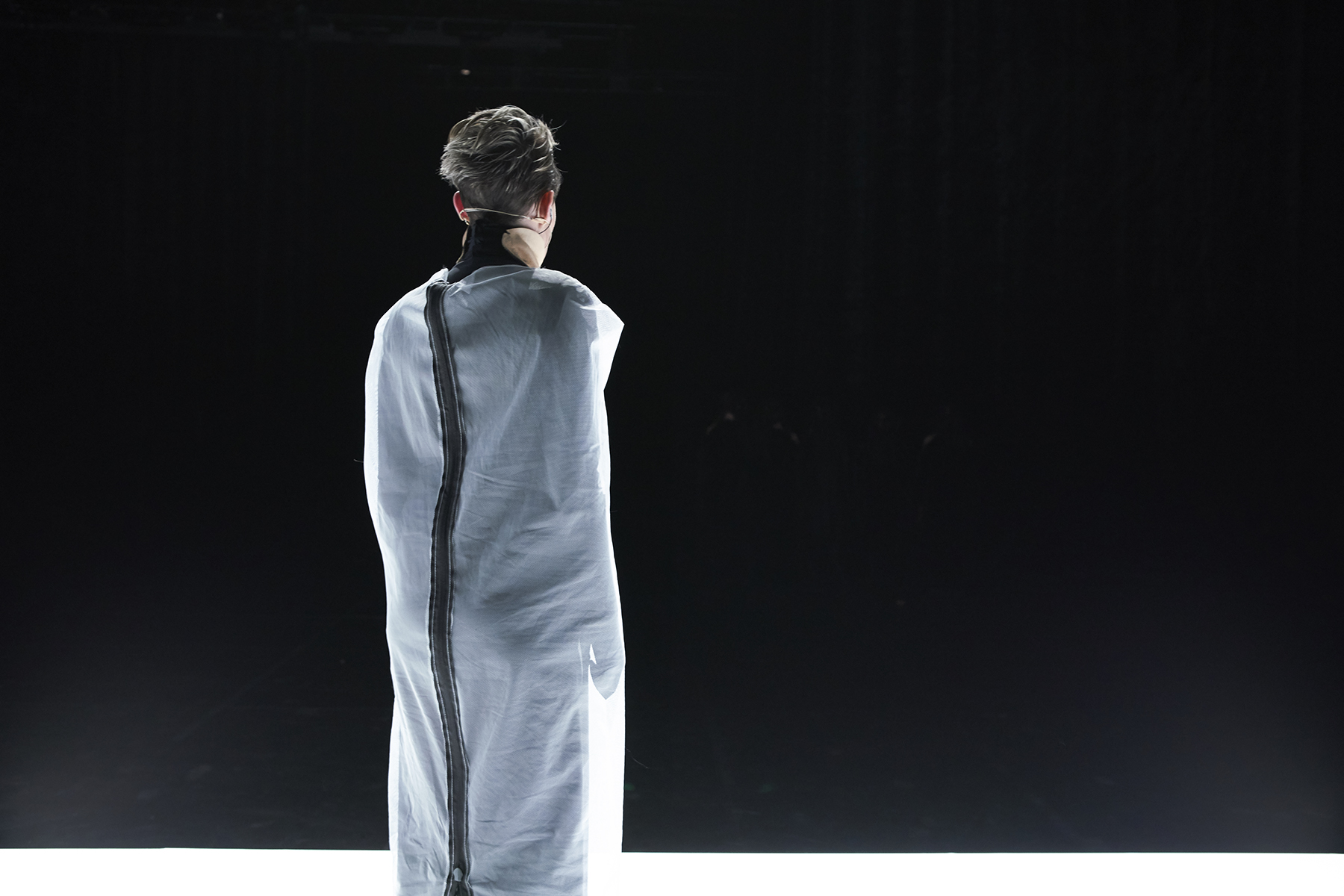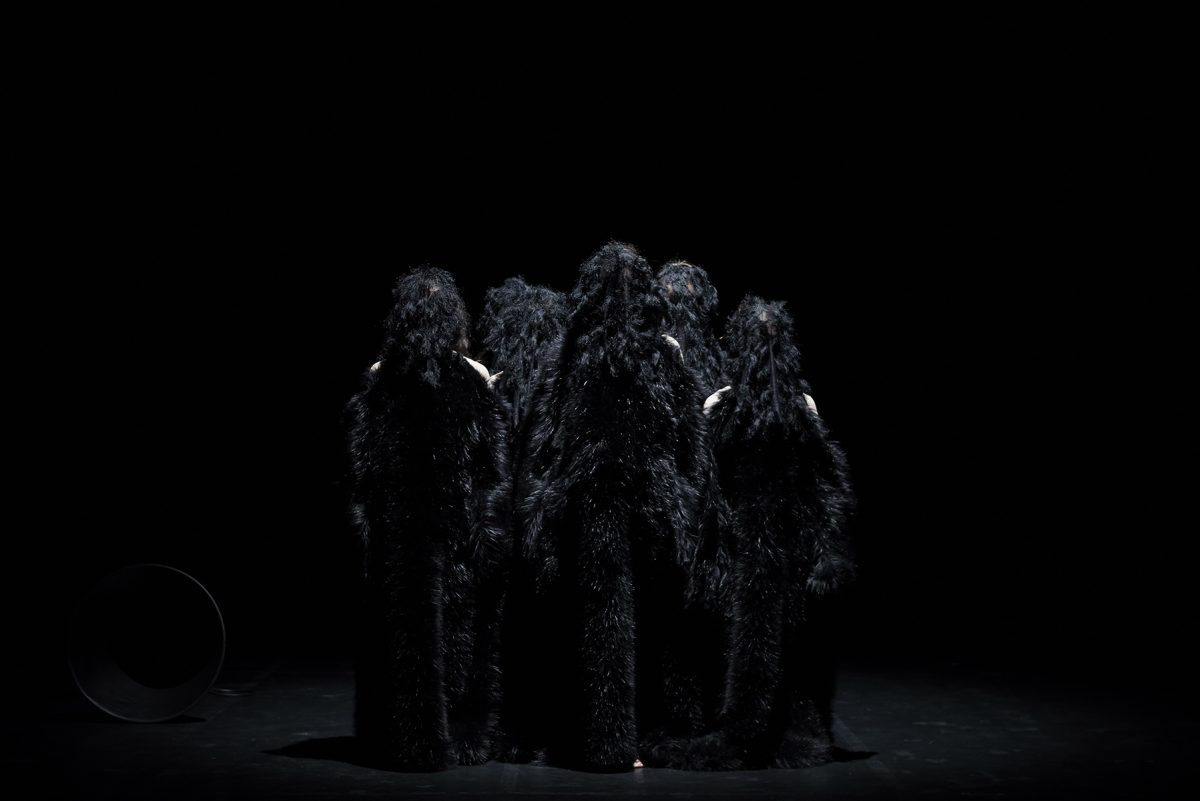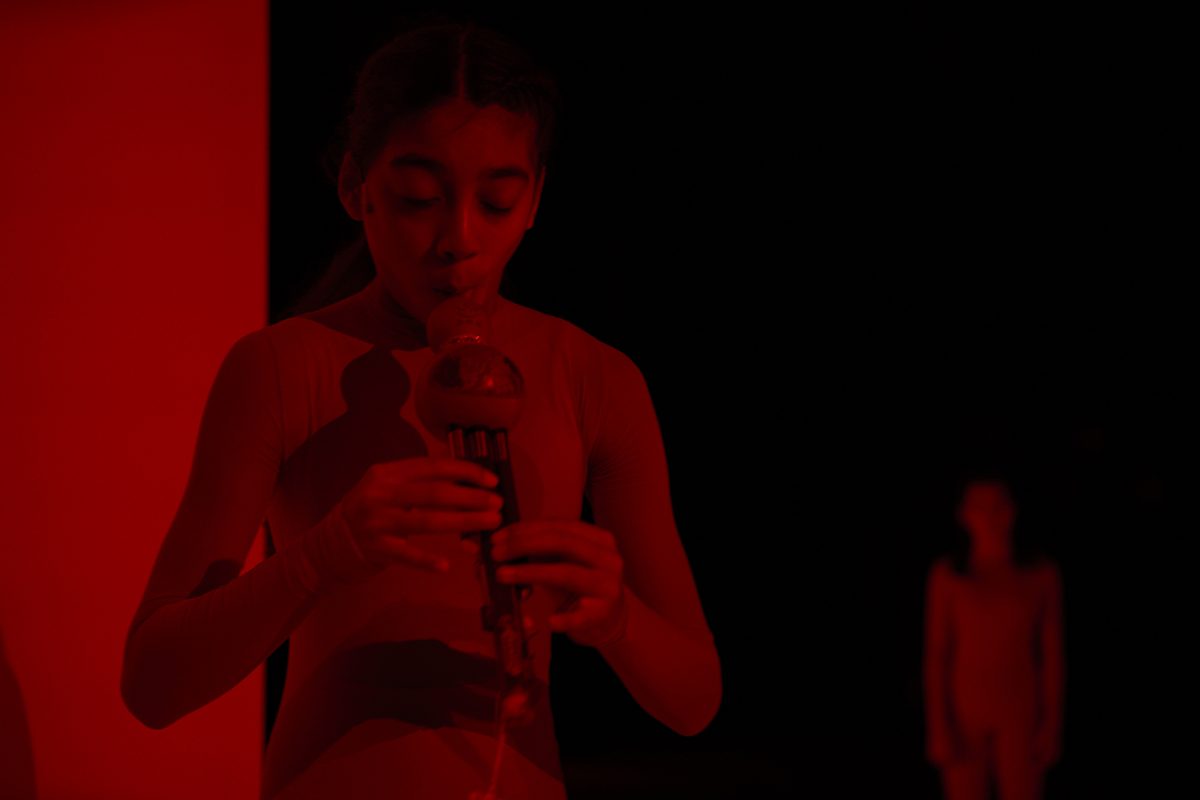
Sydney Chamber Opera’s The Howling Girls: Voicing trauma
A dauntingly large, acutely white picture frame proscenium looms steeply before the audience. Within, a radiantly sheened black velvet curtain; behind, a depthless darkness populated from time to time with barely moving ghostly figures. From within this pictorial framing of director Adena Jacobs and composer Damien Ricketson’s The Howling Girls emerges a wordless reverie-cum-nightmare theatre of image, vocal and electronic sound staged by Sydney Chamber Opera at its boldest, probing trauma symptomatology and “female hysteria,” channelling the mysterious suffering of five New York girls in the wake of 9/11.
In an enduring initial blackout I hear breathing like my own on a still night bereft of moon and stars. Though sonically wrapped around me, it’s not mine, this slow, slightly urgent inhalation, a click in the throat and then exhalation, regular and insistent and subsequently textured with a whispering whistle and the light slap of saliva. I’m in the dark, inside another’s head, while before me the breather (soprano Jane Sheldon) is slowly revealed, reclining in the deep distance in a thin sliver of light, her breathing now voiced, possibly faster, possibly anxious, with a soft rasp.
An intense white light appears across one end of her body and repeatedly tracks down its length, like an MRI scanner, suddenly literalising Sheldon’s character as suffering a condition under investigation, increasing the sense of anxiety. At the same time, repetitive vowel series slowly take shape, evolving into soft chant-like sequences from which eventually comes a surprising, full-bodied, sharp-edged ‘naaaahh’ and the beginnings of a haunting emergent musicality.
Intermittent, otherworldly rumblings and dark glissandi hauntingly punctuate and weave into the increasingly reverberant, amplified voice, intensifying the drama of its evolution from low, tense respiration into seemingly unconscious ritualistic invocation. On the other side of the stage stands a barely perceptible cluster of shadowy figures, forming a piercing chorus of young female voices extending in substantially long notes Sheldon’s urgent utterances. What commenced as a single state of individual being now assumes a larger if mysterious import in which others give empathetic voice to the woman’s condition and perhaps express their own.
Sheldon rises from her bed and moves forward onto the wide lower edge of the picture frame attired in a lightly furred, seemingly armless garment with a hint of straitjacket. Standing still, she is suddenly rendered breathless and voiceless, choking, gasping and coughing, raw, guttural and profoundly discomfiting for an interminable few minutes. The effort invested in trying to communicate in The Howling Girls’ first movement, Summoning, is devastatingly undone in this second one, Blockage. It simultaneously evokes the symptoms of the young women who inspired director Jacobs to make this work. In the wake of 9/11, five New Yorkers from different parts of the city and unknown to each other, but admitted to the same hospital, believed they had ingested flesh and debris from the explosions. They hadn’t. Their throats constricted, none could eat, seemingly suffering what once would have been labelled collective hysteria.
Emerging eerily from the dark, Jacobs’ howling girls are alien creatures, wrapped in long-stranded, shiny black fur, black hair flopping over faces, their hands clutching tiny skulls (Aztec death whistles), like a cult born of 9/11. Appearing to be naked beneath the fur, they are calm, neither overtly howling nor “hysterical,” but vocally mournful even though their presence is possibly playful, maybe dangerous. Whatever, they abet Sheldon in giving voice to trauma.
In the opera’s final scene, the girls appear in body stockings, simply themselves, constructing a language from scratch from seemingly random syllables in a collective, melodic warbling (bar some eerie, rhythmic stutterings), their choralling in sync with Sheldon, who in glorious melancholy voice (evoking multiple idioms and voice types) moves into the distance towards a thin vertical line of bright light and disappears. The title of this final movement, Broken Aria, suggests the defeat of an operatic “hysteric.” Even so she leaves us with a new generation who should no longer be clinically labelled. Amid their singing the girls play simple instruments evocative of communality and ritual while the overarching score utters frantic electronic signals and industrial growls, countering any too easy idealism.
In a scene prior to this conclusion, Sheldon vocalises wordlessly into a large, long megaphone-cum-finely styled horn, duetting sublimely with a theremin player, their faces unseen in a passage of calm but short-lived transcendence erased by a monumental sound and light drama. The picture frame is bathed in deep pinks and reds; the theremin glides and swoops, electronics thunder, voices scream and a massive crash leaves us quivering in silence. It’s as if a trauma (the soprano’s or the New York girls’ 9/11 experience) has been unwillingly revisited as a cathartic prelude to the final scene of loss and new generation.
With strictly limited movement and an intense focus on sound, each scene in The Howling Girls is abstractly pictorial. But light and its absence, the emergence of bodies from darkness and their disappearance into it, limited but stark colouration and effects like the tight lighting of instruments (a drum in one scene, a theremin in another) suggesting suspension in a dream space, coalesce into an engaging visual dynamic that courses from claustrophobia to shock, to the bright, warm openness of the opera’s final moments with the girls in a welcoming semi-circle before us.
Despite a high level of abstraction, The Howling Girls is a bracingly cogent work (though the significance of the megaphone-cum-horn eluded me) with an implicit narrative trajectory as indicated by the titles of the work’s movements, the literalness of the scanning light in the first, the direct referencing of New Yorkers’ trauma symptoms in the second and third, the vocal symbiosis between Sheldon and the girls, the return of the traumatic experience, and the final image of the passing of a lone Everywoman and the emergence of a new generation of women functioning collectively to create an incipient lyrical language of free-floating vowels and syllables.
The production’s focus on listening is richly rewarding. Jane Sheldon’s virtuosic performance in unchartered territory and Damien Ricketson’s meticulous, fluent scoring reveal the voice in all its staggering dimensions, ranging from its origins in breath, from high soprano to deep mezzo, from head to chest and edging into throat singing. Stress, bordering on hyperventilation, is rendered musical and contemplatively resolved. Jack Symonds’ theremin, keyboard and electronics and Bob Scott’s sound design sustain the material viscerality of the voice while simultaneously enlarging it on an orchestral scale that speaks of its magnificent expressivity. The synthesis of Eugyeene Teh’s set design and Jenny Hector’s lighting evokes a world at once rigidly restraining, nightmarishly depthless and expansively open to possibility. The Howling Girls is a memorable opera without words, sparely physically animated, pictorially and sonically immersive, a remarkable celebration of the voice and, with a utopian aura, a continuation of the feminist project to de-pathologise and give voice to the extremes of women’s experiences.
–
Carriageworks & Sydney Chamber Opera, The Howling Girls, composer Damien Ricketson, musical director Jack Symonds, director Adena Jacobs, set & costume design Eugyeene Teh, lighting design Jenny Hector, sound design Bob Scott, performers Jane Sheldon with members of The House that Dan Built: Grace Campbell, Kittu Hoyne, Kiri Jenssen, Emily Pincock, Jayden Selvakumaraswamy, Sylvie Woodhouse; Carriageworks, Sydney, 28 March-7 April
Top image credit: Jane Sheldon, The Howling Girls, Sydney Chamber Opera, photo Zan Wimberley








